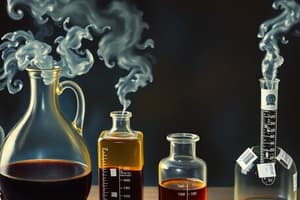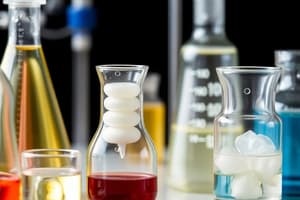Podcast
Questions and Answers
What is the correct name for CuCl2?
What is the correct name for CuCl2?
- Copper Chlorate
- Copper (I) Chloride
- Copper (II) Chloride (correct)
- Cuprous Chloride
Which formula correctly represents Potassium Nitrite?
Which formula correctly represents Potassium Nitrite?
- K2NO3
- K(NO2)2
- KNO2 (correct)
- K2(NO2)3
How should subscripts be indicated in a chemical formula when dealing with oxyanions?
How should subscripts be indicated in a chemical formula when dealing with oxyanions?
- Write the subscript in parentheses before the ion
- Enclose the subscript in parentheses and place it outside (correct)
- Place the subscript before the ion name
- Enclose the oxyanion in brackets after the metal
What is the name for ClO4-?
What is the name for ClO4-?
In the context of naming, what is correct for CuCl?
In the context of naming, what is correct for CuCl?
What is the main purpose of simple separation techniques?
What is the main purpose of simple separation techniques?
Which separation method uses particle size as the basis for separation?
Which separation method uses particle size as the basis for separation?
What is the process of sublimation?
What is the process of sublimation?
Which component of chromatography is where the substance travels through?
Which component of chromatography is where the substance travels through?
What is a distillate?
What is a distillate?
In simple distillation, what factor is primarily used to separate components?
In simple distillation, what factor is primarily used to separate components?
What does the term 'residue' refer to in filtration?
What does the term 'residue' refer to in filtration?
What is the purpose of evaporation in separation techniques?
What is the purpose of evaporation in separation techniques?
What does mechanical picking rely on for separation?
What does mechanical picking rely on for separation?
Which of the following correctly describes John Dalton's Atomic Theory?
Which of the following correctly describes John Dalton's Atomic Theory?
What does decantation involve?
What does decantation involve?
Which statement concerning atomic theory revisions is true?
Which statement concerning atomic theory revisions is true?
Which process is exemplified by removing iron filings from sulfur powder?
Which process is exemplified by removing iron filings from sulfur powder?
According to Dalton’s atomic theory, which of the following is not true?
According to Dalton’s atomic theory, which of the following is not true?
Which of the following is a method of separating solids based on their physical characteristics?
Which of the following is a method of separating solids based on their physical characteristics?
What physical property is primarily used in magnetic separation?
What physical property is primarily used in magnetic separation?
What is the correct name for the compound HF?
What is the correct name for the compound HF?
Which of the following formulas represents an oxyacid?
Which of the following formulas represents an oxyacid?
What is the correct naming convention for a binary acid?
What is the correct naming convention for a binary acid?
What is the formula for Ferric Hydroxide?
What is the formula for Ferric Hydroxide?
Which of the following acids is named using the IUPAC naming convention?
Which of the following acids is named using the IUPAC naming convention?
What type of reaction is defined as a process wherein at least one substance is produced?
What type of reaction is defined as a process wherein at least one substance is produced?
Which formula is correct for the compound KOH?
Which formula is correct for the compound KOH?
What is the chemical name for HlO3?
What is the chemical name for HlO3?
What is produced as a result of a combustion reaction?
What is produced as a result of a combustion reaction?
Which reaction type is characterized by a single compound breaking down into two or more simpler substances?
Which reaction type is characterized by a single compound breaking down into two or more simpler substances?
In a single displacement reaction, what occurs?
In a single displacement reaction, what occurs?
What is the general form of a double displacement reaction?
What is the general form of a double displacement reaction?
Which reaction type is also known as a synthesis reaction?
Which reaction type is also known as a synthesis reaction?
What is the result of the following reaction: CaCO3 → CaO + CO2?
What is the result of the following reaction: CaCO3 → CaO + CO2?
In the reaction 2 KI(aq) + Pb(NO3)2 (aq) → 2 KNO3 (aq) + PbI2 (s), what type of reaction is this?
In the reaction 2 KI(aq) + Pb(NO3)2 (aq) → 2 KNO3 (aq) + PbI2 (s), what type of reaction is this?
What does the term 'products' refer to in a chemical reaction?
What does the term 'products' refer to in a chemical reaction?
Study Notes
Separation Techniques
- Individual substances in mixtures remain distinct; examples include juice, oil, and blood.
- Sublimation: A solid changes directly to vapor, separating two solids; examples are dry ice and mothballs.
- Filtration: Uses a porous barrier to separate solids from liquids based on particle size; results in filtrate (liquid) and residue (solid); used in coffee brewing and water filtration.
- Simple Distillation: Separates mixtures of liquids by heating and condensing vapor back to liquid; based on boiling point differences; example: collecting salt from saltwater.
- Mechanical Picking: Based on physical characteristics to separate solids; example: removing husk from rice grains.
- Magnetic Separation: Uses magnetic properties to separate ferromagnetic substances from nonmagnetic substances; example: removing iron filings.
- Decantation: Separates liquid from solids and immiscible liquids by pouring off the top layer; example: separating oil and water.
Atomic Theory
- John Dalton: Proposed the theory of particle nature of matter and is known as the father of atomic theory.
- Dalton’s Atomic Theory:
- All matter consists of indivisible particles called atoms.
- Each element has unique atoms, differing from others.
- Atoms are not created or destroyed during chemical reactions.
- Atoms of different elements combine in whole number ratios to form compounds.
- Revisions to Dalton’s Theory:
- Atoms consist of smaller particles.
- isotopes exist, leading to mass differences between atoms of the same element.
Compounds and Chemical Naming
- Compounds with Polyatomic Ions: Oxyanions are composed of an element and oxygen; naming involves the metal name followed by the polyatomic ion.
- Binary Acids: Formulas include hydrogen and a nonmetal; named as hydro- + nonmetal-ic acid in aqueous form.
- Oxyacids: Composed of hydrogen and an oxyanion; naming follows the pattern H + Oxyanion.
Types of Chemical Reactions
- Chemical Reactions: Produce at least one new substance and can involve gas evolution, solid formation, or light production.
- Combustion Reaction: Substance reacts with oxygen, producing CO2 and H2O; for example, CH4 + O2 → CO2 + H2O.
- Combination Reaction: Two or more substances combine to form one new product; example: NO + O2 → NO3.
- Decomposition Reaction: A compound breaks down into simpler substances; example: CaCO3 → CaO + CO2.
- Single Displacement Reaction: A more reactive element replaces a less reactive one; example: Zn + CuSO4 → ZnSO4 + Cu.
- Double Displacement Reaction: Exchange of positive ions occurs between two compounds; example: 2 KI + Pb(NO3)2 → 2 KNO3 + PbI2.
Specific Example: Cobalt-60
- Cobalt-60 is used in medical radiation therapy.
- Atomic Number: 27.
- Atomic Mass: Approximately 60.
- Subatomic Particles:
- Protons (p+): 27
- Electrons (e-): 27
- Neutrons (n0): 33.
Studying That Suits You
Use AI to generate personalized quizzes and flashcards to suit your learning preferences.
Description
Explore various separation techniques used in chemistry, including sublimation, filtration, and distillation. This quiz covers methods to isolate individual substances in mixtures like juice, oil, and blood. Test your knowledge on how different physical and chemical properties are utilized for separation.




